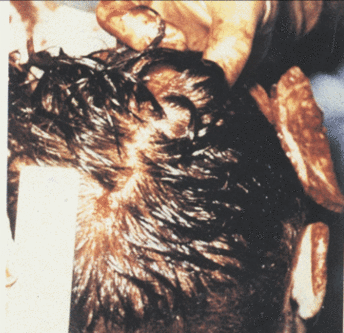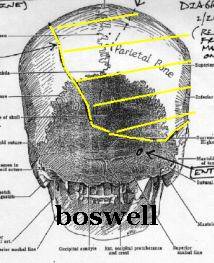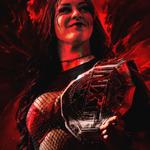DAS ist die Erinnerung von Boswell.
Und natürlich müssen Angaben mit seinen früheren abgeglichen werden, auch mit dem Autopsiereport.
Eintrittswunde irgendwo über dem Ohr
ja, das ist eine abweichende Erinnerung, würde aber nicht unbedingt der groben Angabe einer Wunde im Occiput widersprechen

Interessant, oder? Ein 14cm-Loch OBEN im Kopf
Was hat er den früher ausgesagt?
Regarding the head wound, DR. BOSWELL said the wound was fairly low in the back of the head and that the bone was completely gone above the entry wound. He said that during the autopsy, a piece of skull fragment was brought in which included a portion which corresponded to the missing half of the entry wound in the head
(HSCA interview Purdy, Aug 17, 1977
Dass Kopfhaut im hinteren Bereich in den Hinterkopffotos wieder über das Schädelloch gespannt wurde, sieht man auch am Vergleich zwischen zwei fast identischen Hinterkopffotos, bei denen sich nur die Hand und das Lineal etwas bewegt haben.

Dieses Autopsieformblatt, welches Dr.Boswell zum Teil ausgefüllt hat, hat in den Augen von Boswell und Humes nur Ärger gemacht - weil es von seiner Natur her inakkurat ist.
Wo steht, das es "Ärger" gebracht hat?
Und dass eine Skizze nur eine Skizze ist weiß ich, nur heißt das nicht, dass die Zahlen darauf falsch sind. Ich kann auch grob etwas skizzieren und trotzdem die korrekten Zahlen eintragen. Sonst wäre das Dokument wohl kaum offizieller Teil des Autopsieberichts geworden.
Es gibt keinen Grund, die ursprünglichen 17 cm als falsch anzusehen.
Boswell wurde MEHRFACH im Lauf der Jahrzehnte auf diese 17 cm angesprochen:
During his HSCA appearance, Boswell described it this way: They had to dissect JFK’s scalp to see the entrance wound in JFK’s skull bone, “But not too much,” Boswell explained, “because this bone was all gone and actually the smaller fragment fit this piece down here – there was a hole here, only half of which was present in the bone that was intact, and this small piece then fit right on there and the beveling on those was on the interior surface.”[357]
A few minutes later, Boswell elaborated: “There was a shelf and then a little hole came up on the side and then one of the smaller of the two fragments in that X-ray, when that arrived, we were able to fit that down there and complete the circumference of that bone wound.”[358] During a recorded call in 1994 (a copy of which is available at the National Archives), Boswell told one of the authors (Aguilar) the same thing: “The defect – the wound of entrance was at the base of that defect and the shelving on the inner surface of the bone was half on the intact portion of the skull and half on that fragment that we received from Dallas and replaced.”
Thus, detecting the point the fatal bullet struck the head required some reconstruction of JFK’s skull, and perhaps a little imagination, too. Because the presence of a bullet hole was evidently only detected after two pieces of JFK’s shattered occipital bone were pieced together and a gap, showing internal beveling, could be made out between them.
Dr. Michael Baden asked Boswell about the diagram for the HSCA:
Baden: “Could you explain the diagram on the back [of Boswell’s face sheet]?”
Boswell: “Well, this was an attempt to illustrate the magnitude of the [skull] wound again. And as you can see it’s 10 centimeters from right to left, 17 centimeters from posterior to anterior.”[359]
The problem with Boswell’s testimony is the same problem with his face sheet diagram: it says JFK’s gaping skull wound measured 17-cm. while the autopsy report said it was 13-cm.
The autopsy face sheet prepared by Dr. Boswell during the autopsy.
(see ARRB MD #1)
How did a 17-cm skull defect on the night of the autopsy shrink in the autopsy report? Boswell told the HSCA, [360] the ARRB, and one of the authors (Aguilar, in a recorded call)[361] that it all had to do with the aforementioned beveled bone fragment. The skull defect started out at 17-cm., but after the fragment was replaced into the backside of JFK’s skull, the remaining gap then measured “only” 13-cm., the dimension cited in the autopsy report. Given that the larger number was taken down at the time of the autopsy, it carries even greater weight as evidence than the smaller figure in the autopsy report.
http://www.history-matters.com/essays/jfkmed/How5Investigations/How5InvestigationsGotItWrong_6.htmDas ist wirklich sehr interessant und aufschlussreich über die menschliche Psyche.
Dein Narzissmus, deine kontinuierliche Aggressivität, deine Unfähigkeit, Menschen mit diametral entgegengesetzte Meinung als Individuen zu sehen und deine Projektionen auf mich und andere zeugen nicht gerade von überdurchschnittlicher psychologischer Sensibilität
Du solltest das Boswell und danach das Humes Interview lesen - einfach mal so, ganz unvoreingenommen wie ein Theaterstück.
Natürlich tun sie das! Gerade die Skizzen kommen ja nicht ohne Interpretation aus und dabei zeigt sich das eigentliche Problem der Erinnerung!
Die Auagen beider vor dem ARRB muss man selbstverständlich mit ihren früheren Aussagen und vor allem mit den von ihnen selbst verfassten Dokumenten von 1963/1964 abgleichen. Auf die im Autopsiebericht und in der Skizze enthaltenen Infos trifft die Erinnerungsproblematik NICHT zu- wir wären da schon im Bereich der Bewusstseins- bzw. Wahrnehmungsstörungen.
Zu Humes:
Hier unterscheiden sich in der Tat einige Angaben die er macht von den in Echtzeit entstandenen bzw. noch nicht so sehr von der Erinnerungsproblematik betroffenen entstandenen Informationen und Dokumenten von 1963/1964.
Q Okay. Let me try another question. Can you describe generally where there was any missing bone from the posterior portion, to the best of your recollection?
A There basically wasn't any. It was just a hole. Not a significant missing bone.
Q So a puncture hole--
A Puncture hole.
Q And no bone missing--
A No.
Q --anywhere in the occipital--
A No, no. Unless maybe--you know, these drawings are always strange. Unless the part of this wound extended that far back. I don't think it did, really. Most of it was parietal temporal.
Q So on the scalp of President Kennedy here, still in View No. 4, [above] that underneath the scalp the bone was all intact with the exception of the puncture wound--
A Yeah.
Q --and perhaps some fragment--
A In the back of the skull, back, yes, sir.
Q Are you able to identify whose arm that is holding the President's head?
A No.
Q When that photograph was taken, was the scalp being pulled forward, that is, towards the eyes of the President, in order for that photograph to be taken?
A It's possible. I'm not sure. It looks like that's what's happening. The edge of the defect is up there. The edge of the defect is adjacent to where the fingers and thumb of the person appear on the photograph.
Q I asked you a similar question with another view, but I'd just like to try the same question again. Looking at the posterior skull here, the portion that is below the ear--so if we were to draw a line from between the top of the ear and the top of the ruler down, is it your understanding that the skull behind that scalp would be intact?
A Reasonably intact.in der Tat sagt hier Humes, dass die große Wunde doch nicht so weit nach hinten ging wie hier, ansonsten seine Antworten etwas vage

Das kann verschiedene Gründe haben.
Humes Aussage über 30 Jahre später wird aber nicht von seinem Autopsiebericht gedeckt, der besagt, dass der Defekt nicht nur in den temporalen Bereich hineinreichte, sondern nach hinten in den occipitalen

Das entspricht GROB der künstlerischen Darstellung, die er für die WC anfertigen ließ- dort geht der große Defekt auch sehr weit nach hinten

Die Darstellung Boswells vor dem ARRB und die unter Aufsicht von Humes entstandene Darstellung sind sich sehr ähnlich- im Gegensatz zu der HSCA-Darstellung. Die rote Linie stellt die Lambdanaht dar
Lambdanaht:


Im Grunde genommen bestätigen diese Darstellungen, dass die Kopfhaut in den uns bekannten Hinterkopffotos hinten zurück in die ursprüngliche Position gezogen wurde. Und was sagen Humes und Boswell vor dem ArrB zu diesem aspekt ?
Boswell: Ja, Kopfhaut wurde zurückgezogen bzw. wieder in ursprüngliche Position gebracht
Humes: Es ist möglich, ich bin mir nicht (mehr) sicher, sieht wohl auf dem Hinterkopffoto so aus...
Das sieht man im Vergleich zu deinem Lieblingsfoto.


Zu Boswell:
da wurde eigentlich alles schon zur Hinterkopf gesagt:
Beitrag von bredulino (Seite 548)Mein Argument aber war, dass die im Autopsiebericht genannten 13cm tatsächlich komplett auf dem Bild dargestellt sind, wenn Kennedy nicht den Kopf eines Hobbits hatte (- dazu aber gleich noch mehr) und schon allein deshalb nicht mehr viel Spielraum für weitergehende Öffnungen bleibt.
Da ist nicht unbedingt ein Widerspruch- mit den 13 cm war vielleicht die Strecke bis zum unteren bzw. "hinteren" Rand einer Schädelobersicht erreicht. Und da wäre man schon im Occiput bzw. dem "occipital bone"

bims hintersten Punkt wurde vielleicht dann nicht mehr horizontal entlang der Längsachse gemessen, sondern vertikal , da es sich ja am steil abfallenden Hinterkopf befand, und einfach zu den 14 cm addiert bzw. das Schädelfragment separat gemessen und einfach zu den 13 cm hinzuaddiert
Q. Yes. While you're doing that, let me try a question. Would the measurement for the 17 centimeters begin at the entrance wound and go forward?
A. I think it goes--it's right here, yes.
Interessant, oder? Ein 14cm-Loch OBEN im Kopf
du lieferst ja die Erklärung selbst:
Zu Beginn des ARRB-Gesprächs, bevor die Skizzen oder Fotos genauer betrachtet wurden, beschreibt Boswell die Eintrittswunde am Kopf so:
<Du solltest auch bedenken, dass sich Boswell und Humes der nach dem "JFK"-Film entfachten Diskussionen und freigebenen akten sich der Implikationen einer größeren Kopfwunde bewusst waren und sich bei den ARRB-Interviews in manchen Aspekt eher bedeckthielten bzw. nur Auskunft gaben, wenn sie explizit darauf angesprochen wurden.
NEIN, es könnte NICHT am Ende der Autopsie aufgenommen worden sein, oder siehst Du das Loch in der Brust, wo die Brustplatte entnommen worden ist? Oder ähnliches?
Nur weil es nicht am Ende war muss es nicht am Anfang gewesen sein
Wenn dort, wo Du meinst, ein "Loch" wäre, dann könnte der Schädel nicht auf dieser Auflage liegen, ohne nach rechts zu rollen. <- das ist meine These, die ich als Diskussionsgrundlage einstelle, nicht als Tatsachenbehauptung.
Warum sollte der Kopf nach rechts rollen, wenn er in einer halbRUNDEN Metallfassung liegt, die den Hinterkopf umklammert?
Warum sollte das Foto VOR dem Einsetzen des Fragments aufgenommen worden sein?
Lambach schrieb:Das ist bestenfalls ein Schulaufsatz auf dem Niveau eines Dreizehnjährigen, darüber müssen wir nicht wirklich diskutieren. Eine Verallgemeinerung nach der anderen, alles in einen Topf, wirklich grausam













